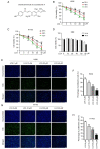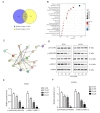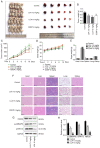Licochalcone A induces cell cycle arrest and apoptosis via suppressing MAPK signaling pathway and the expression of FBXO5 in lung squamous cell cancer
- PMID: 37859622
- PMCID: PMC10620845
- DOI: 10.3892/or.2023.8651
Licochalcone A induces cell cycle arrest and apoptosis via suppressing MAPK signaling pathway and the expression of FBXO5 in lung squamous cell cancer
Abstract
Lung squamous cell carcinoma (LSCC) is a highly heterogeneous malignancy with high mortality and few therapeutic options. Licochalcone A (LCA, PubChem ID: 5318998) is a chalcone extracted from licorice and possesses anticancer and anti‑inflammatory activities. The present study aimed to elucidate the anticancer effect of LCA on LSCC and explore the conceivable molecular mechanism. MTT assay revealed that LCA significantly inhibited the proliferation of LSCC cells with less cytotoxicity towards human bronchial epithelial cells. 5‑ethynyl‑2'‑deoxyuridine (EdU) assay demonstrated that LCA could reduce the proliferation rate of LSCC cells. The flow cytometric assays indicated that LCA increased the cell number of the G1 phase and induced the apoptosis of LSCC cells. LCA downregulated the protein expression of cyclin D1, cyclin E, CDK2 and CDK4. Meanwhile, LCA increased the expression level of Bax, cleaved poly(ADP‑ribose)polymerase‑1 (PARP1) and caspase 3, as well as downregulated the level of Bcl‑2. Proteomics assay demonstrated that LCA exerted its antitumor effects via inhibiting mitogen‑activated protein kinase (MAPK) signaling pathways and the expression of F‑box protein 5 (FBXO5). Western blot analysis showed that LCA decreased the expression of p‑ERK1/2, p‑p38MAPK and FBXO5. In the xenograft tumors of LSCC, LCA significantly inhibited the volumes and weight of tumors in nude mice with little toxicity in vital organs. Therefore, the present study demonstrated that LCA effectively inhibited cell proliferation and induced apoptosis in vitro, and suppressed xenograft tumor growth in vivo. LCA may serve as a future therapeutic candidate of LSCC.
Keywords: F‑box protein 5; apoptosis; licochalcone A; lung squamous cell carcinoma; proteomics.
Conflict of interest statement
The authors declare that they have no competing interests.
Figures







Similar articles
-
[Licochalcone A induces cell cycle arrest in human lung squamous carcinoma cells via the PI3K/Akt signaling pathway].Nan Fang Yi Ke Da Xue Xue Bao. 2023 Jan 20;43(1):111-116. doi: 10.12122/j.issn.1673-4254.2023.01.15. Nan Fang Yi Ke Da Xue Xue Bao. 2023. PMID: 36856218 Free PMC article. Chinese.
-
Liquiritigenin Induces Cell Cycle Arrest and Apoptosis in Lung Squamous Cell Carcinoma.Cell Biochem Biophys. 2024 Jun;82(2):1397-1407. doi: 10.1007/s12013-024-01294-w. Epub 2024 May 22. Cell Biochem Biophys. 2024. PMID: 38775930
-
Anti-Proliferative and Pro-Apoptotic Effects of Licochalcone A through ROS-Mediated Cell Cycle Arrest and Apoptosis in Human Bladder Cancer Cells.Int J Mol Sci. 2019 Aug 5;20(15):3820. doi: 10.3390/ijms20153820. Int J Mol Sci. 2019. PMID: 31387245 Free PMC article.
-
Licochalcone A inhibits interferon-gamma-induced programmed death-ligand 1 in lung cancer cells.Phytomedicine. 2021 Jan;80:153394. doi: 10.1016/j.phymed.2020.153394. Epub 2020 Oct 22. Phytomedicine. 2021. PMID: 33130472
-
Erchen decoction plus huiyanzhuyu decoction inhibits the cell cycle, migration and invasion and induces the apoptosis of laryngeal squamous cell carcinoma cells.J Ethnopharmacol. 2020 Jun 28;256:112638. doi: 10.1016/j.jep.2020.112638. Epub 2020 Jan 31. J Ethnopharmacol. 2020. PMID: 32007633
Cited by
-
Screening of Hub Genes and Therapeutic Drugs in Cervical Cancer Using Integrated Bioinformatics Analysis.J Cancer. 2025 Jan 1;16(1):92-109. doi: 10.7150/jca.87027. eCollection 2025. J Cancer. 2025. PMID: 39744564 Free PMC article.
-
Uncovering proteome variations and concomitant quality changes of different drying methods Cordyceps sinensis by 4D-DIA structural proteomics.Front Nutr. 2025 Feb 5;12:1463780. doi: 10.3389/fnut.2025.1463780. eCollection 2025. Front Nutr. 2025. PMID: 39973924 Free PMC article.
-
The Role of Licorice Chalcones as Molecular Genes and Signaling Pathways Modulator-A Review of Experimental Implications for Nicotine-Induced Non-Small Cell Lung Cancer Treatment.Curr Issues Mol Biol. 2024 Jun 13;46(6):5894-5908. doi: 10.3390/cimb46060352. Curr Issues Mol Biol. 2024. PMID: 38921023 Free PMC article. Review.
-
Analysis and exploration of regulatory mechanisms and potential prognostic biomarkers in squamous cell carcinoma of the lung by expression profiling.Transl Cancer Res. 2025 Jan 31;14(1):569-583. doi: 10.21037/tcr-2024-2443. Epub 2025 Jan 23. Transl Cancer Res. 2025. PMID: 39974402 Free PMC article.
References
MeSH terms
Substances
LinkOut - more resources
Full Text Sources
Medical
Research Materials
Miscellaneous

